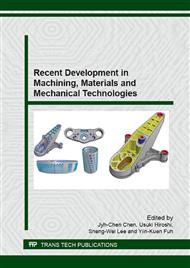p.277
p.283
p.289
p.296
p.302
p.308
p.314
p.320
p.328
Influence of Tool Wear on Cutting Characteristics in Ultra-Precision Cutting
Abstract:
Recently, increasingly high efficiency and high performance have become to be required of information equipment. As a result, optical scanning parts that reduce optical aberrations, scatter, and diffraction are required in laser printers. It is therefore necessary to improve the geometric surface roughness achieved in mirror cutting of Al alloys and eliminate tear-out marks and scratch marks that can be created during the cutting process. In this study, we investigated the effect of tool wear on the occurrence of surface discontinuities in ultra-precision cutting of Al alloys. In our previous studies, a crystal orientation of {110} plane was adopted in cutting an Al-Si alloy (AHS material, 11wt% Si) and Al-Mg alloy (A5186 material, 4.5wt% Mg) using a straight diamond tool. The cutting edge recession that occurs when cutting AHS material has been reported to be approximately 5 times greater than that which occurs when cutting A5186 material. Therefore, we cut the AHS material for accelerated wear and investigated the cutting edge recession, the surface roughness and the cutting force. We found that the cutting edge recession decreases as the tool wear angle γ increase. For example, at a tool wear angle γ = 40°, the cutting edge recession is approximately 7 times greater than that which occurs at a tool wear angle γ = 12°. As the tool wear angle increases, the cutting distance increase, which produces a mirror like surface. In addition, we were able to obtain a good machined surface using a positive tool setting angle because side cutting edge produces residual stock of removal 0.1 μm when the cutting edge recession is 0.3 μm or more and when it is cut by following end cutting edge.
Info:
Periodical:
Pages:
302-307
Citation:
Online since:
July 2015
Keywords:
Price:
Сopyright:
© 2015 Trans Tech Publications Ltd. All Rights Reserved
Share:
Citation:


